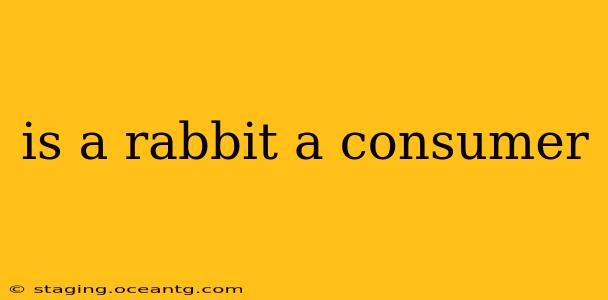Is a Rabbit a Consumer? A Deep Dive into Rabbit Ecology
Yes, a rabbit is unequivocally a consumer in the context of ecological food chains. Understanding why requires a look at the fundamental roles organisms play within ecosystems. Let's explore this further.
What is a Consumer in Ecology?
In ecological terms, a consumer is an organism that obtains energy by feeding on other organisms. They cannot produce their own food like plants (producers) through photosynthesis. Instead, they rely on consuming other living things to survive. Consumers are categorized into different levels based on what they eat. Rabbits, as herbivores, occupy a specific niche within this system.
Why are Rabbits Considered Consumers?
Rabbits are herbivores, meaning their diet consists entirely of plant matter. This plant matter, produced by photosynthetic organisms (producers), serves as the rabbit's primary energy source. By consuming plants like grasses, clover, and vegetables, rabbits are directly obtaining energy that was originally captured from sunlight by the plants. This makes them primary consumers, the first level of consumers in a food chain.
What Do Rabbits Eat? A Detailed Look at Their Diet
Understanding a rabbit's diet is crucial to understanding its role as a consumer. Their diet is primarily composed of:
- Grasses: Various types of grasses form the bulk of a wild rabbit's diet.
- Forbs: These are non-woody flowering plants, rich in nutrients and crucial for a rabbit's health.
- Legumes: Plants like clover are a vital source of protein for rabbits.
- Vegetables (in captivity): Domestic rabbits often receive supplemental vegetables as part of a balanced diet.
Are There Different Types of Consumers? What About Rabbits?
Yes, there are various types of consumers in ecosystems. Here’s how rabbits fit in:
- Primary Consumers: Rabbits are primary consumers because they feed directly on producers (plants).
- Herbivores: As mentioned, their diet exclusively consists of plant matter.
Rabbits do not occupy higher consumer levels like secondary or tertiary consumers, which are carnivores or omnivores that prey on other animals.
What Happens to the Energy Rabbits Consume?
The energy rabbits gain from consuming plants is used for various life processes:
- Growth: Fueling the growth and development of the rabbit.
- Movement: Providing energy for running, hopping, and other activities.
- Reproduction: Supporting reproductive functions.
- Body Temperature Regulation: Maintaining a constant body temperature.
What Would Happen if Rabbits Were Removed From an Ecosystem?
Removing rabbits from an ecosystem would have cascading effects. The immediate impact would be on the plants they consume, potentially leading to an overgrowth of certain plant species. Predators that rely on rabbits as a food source would also be affected, potentially experiencing population declines or needing to adapt their diets. This highlights the interconnectedness of organisms within an ecosystem and the crucial role even primary consumers like rabbits play.
In conclusion, a rabbit is definitively a consumer, specifically a primary consumer and a herbivore, playing a vital role within its ecosystem's complex food web. Understanding this fundamental ecological role is key to appreciating the interconnectedness of life on Earth.
